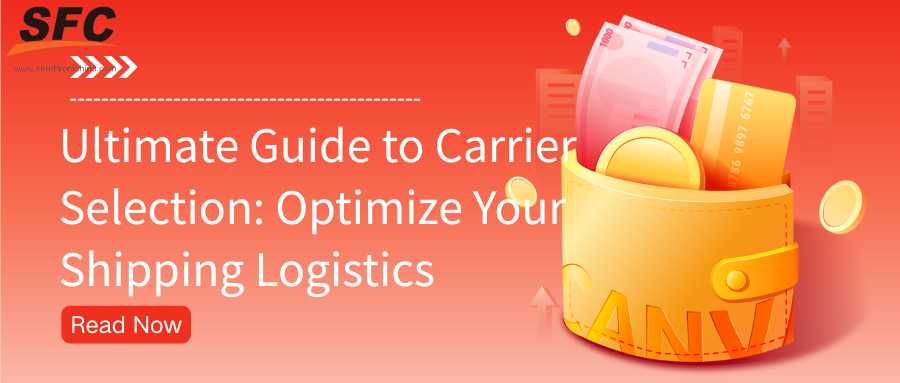In today’s global supply-chain environment, selecting the right carrier is more than just a logistics decision — it’s a strategic one. Whether you’re shipping from China to global markets or managing domestic flows, the choices you make around carriers influence cost, service, risk, and ultimately your brand reputation. Let’s walk through a full-colour guide to carrier selection, step by step.
1. What Is Carrier Selection
Carrier selection is the process of choosing the transportation service provider(s) that will move your goods from origin to destination. It’s not just booking the cheapest truck, ship or air-freight – it’s evaluating how a carrier aligns with your business requirements: service levels, geographic coverage, equipment types,
transit time, reliability, cost structure and more.
In effect, carrier selection sits at the heart of logistics optimization: you are choosing the link-in-the-chain that connects manufacturing (or sourcing) through to order fulfillment. As one industry piece states, “Carrier selection involves evaluating and choosing transportation providers based on factors like cost, reliability, delivery times, and service quality.”
2. Why Carrier Selection Matters More Than Ever
Think of your carrier network as a visible extension of your brand. A late delivery, damaged pallet, or mis-handled customs clearance doesn’t just cost freight; it costs trust.
Key drivers
Customer expectations: End‐consumers expect faster, transparent, and seamless delivery. According to one industry analysis, 82 % of customers consider free shipping important and 68 % prioritize shipping speed.
Cost pressures: Freight, fuel surcharges, border regulations—these are all rising. The wrong carrier can lead to hidden fees, delays, and margin erosion.
Global complexity: If you’re
shipping from China, across borders, into third-party markets, you need carriers who understand customs, duties, regional hubs, and compliance.
Brand reputation: The carrier is physically delivering your product, so their performance – on‐time, undamaged, clear tracking – reflects directly on you. As noted by Bringg: “These companies are your brand representatives.”
3. Define Your Shipping Profile (Before Carrier Evaluation)
Before you begin vetting carriers, you need clarity on what you need. Without that, you’re comparing apples and oranges.
Ask yourself:
What is the volume of your shipments? (e.g., small parcels, pallets, full-truckloads)
What are your destinations? Domestic, cross-border, international? Are there remote locations?
What’s your budget? And what trade-offs are you willing to make between cost and service?
What kind of tracking, communication, and visibility do you need?
What is your
risk tolerance? (Damage,
delay, customs hold, insurance)
For example: If you’re shipping mid-volume electronics from China to Europe with a two-day delivery promise for your end customer, you’ll need a different carrier profile than a low-cost, slow ocean freight for bulky furniture.
4. Carrier Types & Their Roles
Carriers come in many shapes. Understanding their capabilities will help match them to your shipping profile.
Common carrier types
National / Major carriers: Large, global players with extensive networks. Broad coverage but sometimes higher cost and less flexibility.
Regional carriers: Smaller footprint, often more flexibility and potentially better cost in niche lanes. But may lack full global reach.
Specialised carriers: For temperature-sensitive, hazardous, or oversized freight. They bring expertise and equipment but cost more.
Freight forwarders / 3PLs: These intermediaries contract carriers on your behalf, which can give you access to a broader network. Useful if you’re shipping from China and want a full-service chain.
When to use which
For high-volume, predictable lanes → national/regional carriers with locked in rates.
For niche lanes, cross-border, or special freight from China → specialised carriers or 3PLs.
For flexibility and multiple carriers (to avoid single-carrier risk) → carrier portfolio approach.
5. Key Criteria for Evaluating Carriers
Now we move into the core of the process—how to evaluate a carrier. The following checklist covers high-impact criteria.
| Criterion |
Why It Matters |
What to Investigate |
| Service capability & match |
If the carrier cannot handle your freight type, geometry, or special requirements, you’ll face issues. |
Ask: Do they handle your freight type? Are they equipped with correct trailers/fleet? |
| Geographic coverage / transit time |
Reaching the correct origin-destination lanes, crossing borders, and covering remote areas is critical. |
Do they cover the required regions? Do they understand customs/legalities (especially from China)? |
| Reliability & performance history |
On-time delivery, low damage/loss rates, stable capacity matter. |
Ask for historical performance: on-time %, claims ratio, references. |
| Technology & visibility |
Real-time tracking, shipment visibility, integrations with your systems. |
Does the carrier provide live tracking? Does it integrate into your TMS/WMS? |
| Cost structure & hidden fees |
Not just the headline rate – surcharges, accessorials, fuel, waiting time all matter. |
Ask for full breakdown of fees, when surcharges apply. |
| Insurance, safety & compliance |
Especially when shipping internationally (China → elsewhere) you need carriers who comply with regulations. |
Verify licences, certifications, claims handling, safety record. |
| Capacity & scalability |
You want a carrier who can grow with you, handle peak season, etc. |
Ask: What’s your capacity during peak? What is contingency plan if capacity is constrained? |
| Financial stability |
A carrier going out of business or cutting corners can bring enormous risk. |
Check for creditworthiness, years in business, fleet ownership or lease. |
| Relationship & culture fit |
Logistics is a partnership. Communication, responsiveness, and alignment matter. |
How easy is communication? What is the escalation protocol when something goes wrong? |
6. Build Your Carrier Scorecard & Selection Process
When you reach the step of evaluating and selecting carriers, having a structured scorecard and a disciplined process makes all the difference. A good scorecard transforms subjective judgments into data-driven decisions and enables continuous monitoring and improvement. Here’s how to build it properly and use it effectively, with special focus on China-origin shipping flows.
Why the Scorecard Matters
Before diving into how, let’s remind ourselves why a rigorous carrier scorecard matters:
It gives you objectivity — you compare carriers on the same criteria rather than gut feeling.
It enables accountability and transparency — you and the carrier both understand what metrics are important and how performance is measured.
It helps you drive improvement over time — rather than just signing contracts and forgetting them.
It supports risk-management — you identify weak carriers early, monitor for spikes in damage/claims, capacity issues, etc.
And, from a
China-based 3PL perspective, you can compare carriers who understand Chinese export operations, bonded zones, multi-modal routing, customs clearance, etc — all of which are harder to measure without a scorecard.
Define Your Scorecard Framework
To construct your scorecard, follow these sub-steps:
Clarify your shipping lanes, freight profile and priorities
Since your operations are China-origin (and may be global outbound), start by mapping your major lanes: e.g.,
Factory in Shenzhen → Europe, air freight door-to-door
Shanghai bonded warehouse → US West Coast, ocean + drayage
Inland China pickup → Asia Pacific regional delivery, LCL/FTL Knowing your freight types (small parcels, pallets, FTL, temperature-sensitive), volumes, and service levels helps you decide which criteria matter most for each lane.
Select your evaluation criteria (and weights)
Pick the key attributes you care about in a carrier. Typical ones include:
On-time pickup/delivery
Transit time consistency
Damage/loss/claims ratio
Cost (total cost, not just headline rate)
Invoice accuracy & billing transparency
Communication & visibility (tracking, alerts)
Capacity and scalability (especially during peaks)
Compliance (customs, export, bonded zones especially for China)
Technology readiness (EDI/API, integration with your TMS)
Relationship/fit and responsiveness
Sources show that major shippers use dozens of such KPIs.
Then you assign a
weighting to each criterion based on how important it is to your company. For instance, for a high-value electronics outbound from China to EU, you might weight “on-time delivery” 30 %, “damage/claims” 20 %, “cost” 15 %, “visibility/technology” 15 %, and the rest distributed among other criteria.
Create the scoring grid/template
Once you’ve defined the criteria and weights, build a simple template for each carrier: Target → Actual → Score. For example:
| Criterion |
Target |
Weight (%) |
Actual |
Score (Weight × Performance) |
| On-time delivery |
95% |
30 |
92% |
27.6 |
| Damage rate |
<1% |
20 |
0.80% |
18 |
| Cost (landed) |
US$1,000 avg |
15 |
US$1,050 |
14 |
| Visibility/tech |
Fully integrated API |
15 |
Partially integrated |
12 |
| Compliance (customs/export) |
100% trainable |
10 |
100% |
10 |
| Capacity scalability |
Able to scale +30% peak |
10 |
Yes |
10 |
| Total Score |
— |
100 |
— |
91.6 |
Collect relevant data
You’ll need historic shipment data, carrier self-reporting, audit/validation data from your systems, and ideally comparative benchmarking. Some carriers may hesitate to share full details — so you should plan audits, charge-back or claims records, pilot shipments, and integrate tracking/visibility to capture real performance. Automation helps: as one article says, “A carrier scorecard is a performance evaluation tool … companies can gain valuable insights into their carriers’ reliability and service quality.”
Selection Process Using the Scorecard
Once you have the framework and data, here’s how you run the process:
Step 1: Shortlist carriers
Based on your lane mapping and service needs, identify a pool of potential carriers — for example, 3-5 for each major lane. Include global majors (for scale), regional specialists (especially for origin/international bridging from China) and niche carriers (if you have special freight). You may tap your own 3PL network, ask for recommendations, or use RFPs.
Step 2: Issue Questionnaire / RFI
Send the carriers your structured questionnaire which includes: company profile, fleet/modal capabilities, coverage map (especially origin China + destination market), performance metrics (on-time %, damage %, capacity, etc), technology stack (tracking, API/EDI), compliance & safety credentials, insurance, financial stability, and cost structure (including surcharges, accessorials).
Step 3: Score and rank candidates
Populate your scorecard template with the actual responses/data. Rank carriers by total score. Generally, those with higher scores are better aligned. But remember: score is a tool — not the only input. Consider qualitative factors like strategic fit, relationship, flexibility, and cost negotiation.
Step 4: Pilot key lanes
Before fully committing long-term, select 1–2 lanes (ideally representative of your critical flows) to test the top-scoring carriers. For example: run a shipment from China factory → EU warehouse and measure actual performance: transit time, pickup reliability, customs clearance delays, damage claim, visibility quality. This test gives real-world validation of the scorecard data.
Step 5: Contract & negotiate KPIs
Based on the results, negotiate your carrier contracts and SLAs. Use the scorecard metrics to set performance expectations: e.g., 95% on-time delivery, <0.5% damage rate, invoice errors <1%, weekly tracking data submission, etc. Agree on incentives and penalties: e.g., bonus for >98% on-time; penalty or review if <90% on-time or damage rate >1%. Clarify escalation paths for non-performance.
Also clarify cost structure: base rate, fuel surcharges, detention, demurrage, customs hold charges. Since you ship out of China, include export-related accessorials (bond-zone handling, documentation, customs holds) and ensure all hidden fees are surfaced upfront.
Step 6: On-board & integrate
Once contracted, integrate the carrier into your systems: connect tracking feeds, EDI/API, performance reporting, scheduled reviews. Work with them to understand your internal processes (e.g., pickup windows at your China warehouse, documentation hand-off, packaging standards). Provide training/communication so they know your expectations (e.g., China export doc submission timeframe, holidays, peak seasons).
Step 7: Monitor & review
The scorecard must become a living document, not a one-time exercise. For each carrier, track their actual performance monthly or quarterly. Compare actual vs target. Highlight deviations, discuss root cause with carrier, put corrective action plans in place. One article states: “Carrier scorecards should be reviewed regularly (e.g., monthly and quarterly) with your carriers to help contextualise their performance and iterate on future transportation strategies.”
Step 8: Adjust your carrier portfolio
Maintain a pool of carriers and avoid over-reliance on a single partner. Using scorecard insights, you may shift volume to higher-performing carriers, retender lanes with under-performers, or explore new carriers for emerging lanes. As your business grows (especially globally from China), your lane mix may change — your scorecard framework helps you evolve accordingly.
Practical Tips for China-Origin Logistics
Since you are based in China and many of your flows originate here, apply these additional nuances:
Ensure the scorecard explicitly covers origin China operations: first-mile pickup in China, export documentation, customs clearance, consolidation (if sea/rail), hand-off to ocean/air/rail carrier, and final destination leg. Rate carriers not just for the international leg but the full chain.
Include multi-modal capability: many China exports move via sea + rail + drayage, or air + last-mile. Carriers (or their networks) who provide seamless multi-modal transition perform better.
Evaluate local Chinese network maturity: Do they have local staff, warehouses, bonded zones in China? Do they understand Chinese regulatory nuances (customs, free-trade zones, export license)?
Account for peak season and capacity constraints: Chinese export markets often see surges (e.g., Q4, Chinese New Year) and carriers may have capacity bottlenecks or higher rates. Monitor capacity/rate trends and ensure your carrier can scale.
Monitor export documentation & customs holds: Even carriers with strong arrival-leg performance may stumble on Chinese export paperwork – the scorecard should track missed exports, customs delays, hold-times, and remediation.
Visibility across cultures/time-zones: Because you are operating internationally, the carrier’s communication workflows (China origin + destination market) are essential. Technology/trackability must adapt across languages and time zones.
Hidden costs in China origin: For example, re-packing, pallet consolidation, export bundling, container detention, port demurrage — ensure these are flagged during the RFI and scored accordingly.
Advanced Features of a Mature Scorecard
As your logistics maturity grows, you can enhance your scorecard with advanced capabilities:
Predictive modelling and benchmarking: Use analytics to not only track historic performance but forecast which carriers are likely to under-perform in upcoming seasons or lanes.
Automated data feeds: Rather than manual Excel sheets, integrate your TMS/
WMS and carrier systems so metrics are captured real-time. “Manual score-carding is time-consuming… Automated systems enable a more objective form of carrier score-carding.”
Dynamic weighting: Depending on lane or freight type, adjust the weightings of criteria dynamically. For example, for one lane visibility might matter more; for another, cost may dominate.
Dashboard & alerting: Build dashboards that flag low-performing carriers (‘red’), average (‘yellow’), high performers (‘green’). This allows your logistics team to react swiftly when a carrier dips below threshold.
Continuous improvement / carrier development: Use the scorecard not just to weed out bad carriers but to engage with carriers on improvement plans. For carriers who consistently miss visibility targets, schedule quarterly reviews and improvement road-maps.
Integration into procurement / RFP cycles: Use scorecard data when you tender new business or renegotiate contracts. Good performance should earn carriers preferential volume or incentives; poor performance should lead to review or replacement.
Risk & compliance overlay: Add metrics for regulatory compliance, sustainability (e.g., carbon footprint, where relevant), safety incidents, insurance claims, and security audits.
Common Mistakes & How to Avoid Them
Collecting no data / only ad-hoc review: Without consistent data, you end up with anecdotal carrier opinions rather than facts.
Using only cost as criterion: Many shippers fall into the trap of awarding to the lowest cost carrier; but this often leads to hidden costs of delays, damage, reputational loss. (As we saw earlier in the broader article.)
Over-complicating the scorecard: Too many criteria and minute metrics can make the process unwieldy and unmanageable. Start simple, then build up.
Not communicating with carriers: If the carrier doesn’t know which metrics they are being judged on, you lack buy-in. Scorecards are best when used collaboratively.
Treating the scorecard as static: Logistics and trade-flows evolve (especially when shipping out of China). You must keep the scorecard under review, update weightings, and adapt to changes in volume, lane, mode, cost structure.
Failing to act on poor performance: The scorecard is only useful if it triggers action: corrective plans, contract renegotiation, replacement of carrier, or shifting volumes.
Summary of Extended Process
To summarise the extended process:
Map your freight profile (China-origin lanes, volumes, service needs).
Define criteria and weights tailored to your business and the unique China-origin context.
Build a scoring template.
Collect data (historic, current, pilot).
Issue RFIs and evaluate carriers.
Score and rank the carriers.
Pilot shipments on key lanes.
Negotiate contracts with SLA/KPIs and cost transparency.
Onboard carriers, integrate systems.
Monitor performance via monthly/quarterly reviews.
Use dashboards, alerts, and analytics for real-time oversight.
Adjust your carrier portfolio proactively.
Use the data for continuous improvement and better procurement decisions.
7. How to Optimize your Carrier Network
Having a number of vetted carriers is good. Having a well-optimized carrier network is better. Here are strategies to optimize:
Segment your lanes and match carriers accordingly Not every lane is equal. Segment lanes by volume, value, service requirement, risk, geography. For high-volume steady lanes you may pick a dedicated, contract carrier; for low-volume or sporadic lanes you may use multiple spot carriers or 3PL network. Diversify your carrier base accordingly. A blog post from ShipBob emphasises that carrier diversification gives you flexibility, redundancy and negotiating power.
Leverage multi-carrier strategies Instead of relying on one mega-carrier for everything, using multiple carriers (or a mix of regional + global + specialized) allows greater flexibility, competitive pricing and risk mitigation.
Use technology tools / TMS / multi-carrier shipping software Carrier selection is complicated; to manage multiple carriers, you should use tools that automatically select the best carrier for each shipment based on cost, service, lane, capacity. Data visibility allows you to rotate carriers, compare performance and make proactive changes.
Review and rebalance periodically Carrier performance, cost structures and your business needs evolve. Set periodic reviews (quarterly or semi-annually) to assess whether each carrier still meets requirements. If not, rebalance your network: drop under-performers, add new carriers, renegotiate terms.
Negotiate effectively Once you have data and performance history, you are in a better position to negotiate: volume tiers, service incentives, penalty clauses, consolidated billing, accessorial caps. One tactical guide emphasises that “selecting the right shipping carrier and negotiating competitive rates are strategic imperatives.”
Align incentives and build partnerships Treat your best carriers as partners: share performance data, forecast volumes, co-develop improvement plans. A strong relationship means carriers will prioritise you when capacity is tight, and may offer better pricing or service.
Risk mitigation and contingency planning Have fallback carriers on priority for each critical lane. Maintain alternate carrier contracts or standby capacity so that disruptions (e.g., natural disaster, port strike, equipment shortage) don’t derail operations.
Optimize for mode and route selection Sometimes the carrier choice is also a mode/route choice. For example: ocean vs air, full container load vs less than container load (LCL), rail vs truck in China-Europe. Align carriers with the correct mode and route to optimize cost and service.
Track and measure carrier portfolio health Metrics to track: cost per shipment, cost per unit, on-time delivery %, delay‐days, claims per unit, damage rate, invoice accuracy, accessorial spend, customer satisfaction related to delivery. Use these metrics to identify carriers that are creeping above cost or dropping in performance.
8. Conclusion
Selecting the right carriers is not a one-off logistics procurement exercise; it is a strategic investment in your supply chain. By understanding your shipping profile, distinguishing carrier types, applying rigorous evaluation criteria, building a robust scorecard and maintaining an optimised carrier network, you build not just transport capacity but competitive advantage.
9. FAQs
Q1: How many carriers should I work with?
A: There’s no one-size answer. For core high-volume lanes you might have 1-2 primary carriers and a backup. For lower-volume or less critical lanes you might work with multiple carriers in a flexible pool. The key is balance: too few means risk; too many means complexity.
Q2: Should I always pick the cheapest carrier?
A: No. Cost is important, but a carrier that fails on on-time delivery, equipment reliability or customer experience may cost you more in the long run (claims, lost business). Reliability and alignment with your profile matter just as much.
Q3: How often should I review carrier performance?
A: Best practice is at least quarterly, though high-volume or strategic lanes may warrant monthly reviews. The goal is to spot and correct downward trends before they impact your business.
Q4: What role does technology play in carrier selection?
A: A significant one. Carriers or 3PLs with good technology (real-time tracking, APIs, dashboards) give you visibility, control and data-driven decision-making. Without that you’re flying blind.
Q5: For shipments from China, what special considerations apply when selecting carriers?
A: Key considerations include: experience with cross-border customs and duty; origin port/terminal connectivity in China; ability to handle air/sea/rail modes; last-mile delivery in destination market; service reliability in export lanes; communication and time-zone alignment. Partnering with a China-based 3PL like SendFromChina ensures access to carriers and network best suited for origin-country complexity.





 Post Views:29
Post Views:29
 Want to know about our services, fees or receive a custom quote?
Want to know about our services, fees or receive a custom quote? Please fill out the form on the right and we will get back to you within a business day.
Please fill out the form on the right and we will get back to you within a business day.
 The more information you provide, the better our initial response
will be.
The more information you provide, the better our initial response
will be.




 TAGS:
TAGS: